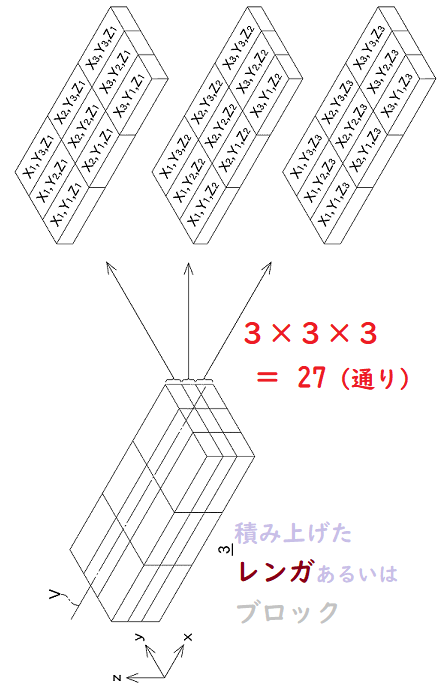
関係算術の形式的法則(formal laws)の証明に際して,我々はしばしば系列の系列の系列を扱う機会がある。これは次の例によって心に描くことができる。(即ち、)我々は多くの煉瓦を積み重ねないといけないと想定しよう。そして事柄をより興味深くするために、煉瓦がみな金(でできた煉瓦)であり、我々はフォート・ノックス(注:アメリカのケンタッキー州のフォート・ノックス軍事基地のことで、基地内に米国金塊貯蔵所が置かれている)に雇われていると仮定しよう。まず(横)一列(a row 一行)に(黄金製の)煉瓦を並べることとして、初めに置いた煉瓦の真東(due East)に次の煉瓦を置いていく。次に別の列を作ることとし、前の列に接しかつその真北に煉瓦を置いていく。以下、適当と思われる数の列ができるまで、同様の作業を続ける。続いて、この第一層の上に第二層を積む(第二層の上には第三の層を積み、順次、(用意した)全ての煉瓦が積み重なるまで続ける。その場合(then)、各列はひとつの系列(series)であり、各層(注:第一層、第二層・・・)は系列の系列(series of series)であり、積みかさねた全体は、系列の系列の系列(series of series of series)である。この過程(プロセス)は次のように記号化できる。Pを諸層の間の上(層)から下(層)への関係とする。そこでPの範囲は諸層から成っていることになる。各層は列の系列である。Q1 を最上層の諸列の間の、南から北への関係とし、Q2を第二層の諸列間の関係とし、以下同様とする。Q1の範囲は「列」の系列であることになる。最上層の南の端の「列」における東から西への関係をRllと呼ぼう。Rl2は最上層の第二列における東から西への関係であり、同様に進んで、Rmnにいたる。このときmは「層」の数であり、nは各層における「列」の数である。さてこの例では、「層」や「列」の数を有限だと想定したが、これは例を単純にするためにのみなされた全く不必要な制限である。これらすべてのことは日常の言語で言うと複雑で長たらしくなるが、記号を使用すれば短く容易である。x がPの範囲にある一要素であるときx のPへの関係をFとしよう。すると F3はFとFとFとの関係積である。そこで、たとえば、個々の煉瓦は、Pに対してF3という関係をもつ諸項である。言いかえれば、個々の(一つひとつの)煉瓦は、Pの範囲の要素(成員)の範囲の要素(成員)の範囲の要素(成員)である。こういう系列の系列の系列は、加法と乗法とに対する結合法則を証明するために必要なのである。
Chapter 8 Principia Mathematica: Mathematical Aspects, n.17 In proving the formal laws of relation-arithmetic we often have occasion to deal with series of series of series. These can be visualized by the following illustration: suppose you have to make a stack of a number of bricks and, to make the matter more interesting, let us assume that they are gold bricks and you are employed at Fort Knox. I shall assume that you first make a row of bricks, putting each brick due East of the previous one; you then make another row, touching your first row but due North of it; and so on, until you have made as many rows as seems appropriate. You then make a second layer on top of the first layer; and a third on top of the second; and so on, until all the bricks are stacked. Then each row is a series, each layer is a series of series, and the whole stack is a series of series of series. We can symbolize this process as follows: let P be the relation of above to below among the layers; the field of P will consist of the layers; and each layer is a series of rows. Let Q1 be the relation South to North among the rows of the top layer, Q2 the relation among the rows of the second layer, and so on. The field of is a series of rows. Let us call R11 the relation of East to West in the most Southern row of the top layer; the relation of East to West in the second row of the top layer; and so on, ending with if m is the number of layers and n is the number of rows in each layer. In this illustration, I have assumed that the number of layers and rows is finite, but this is a quite unnecessary restriction made only to make the illustration simpler. In ordinary language all this is complicated and lengthy, but in symbols it becomes short and easy. Let F be the relation of x to P consisting in x being a member of the field of P. Then F3 is the relative product of F and F and F. The separate bricks, for example, are the terms having the relation F3 to P – that is to say, each brick is a member of the field of a member of the field of a member of the field of P. We need such series of series of series in proving the associative law for addition and multiplication.
Source: My Philosophical Development, chap. 8:1959.
More info.:https://russell-j.com/beginner/BR_MPD_08-170.HTM
